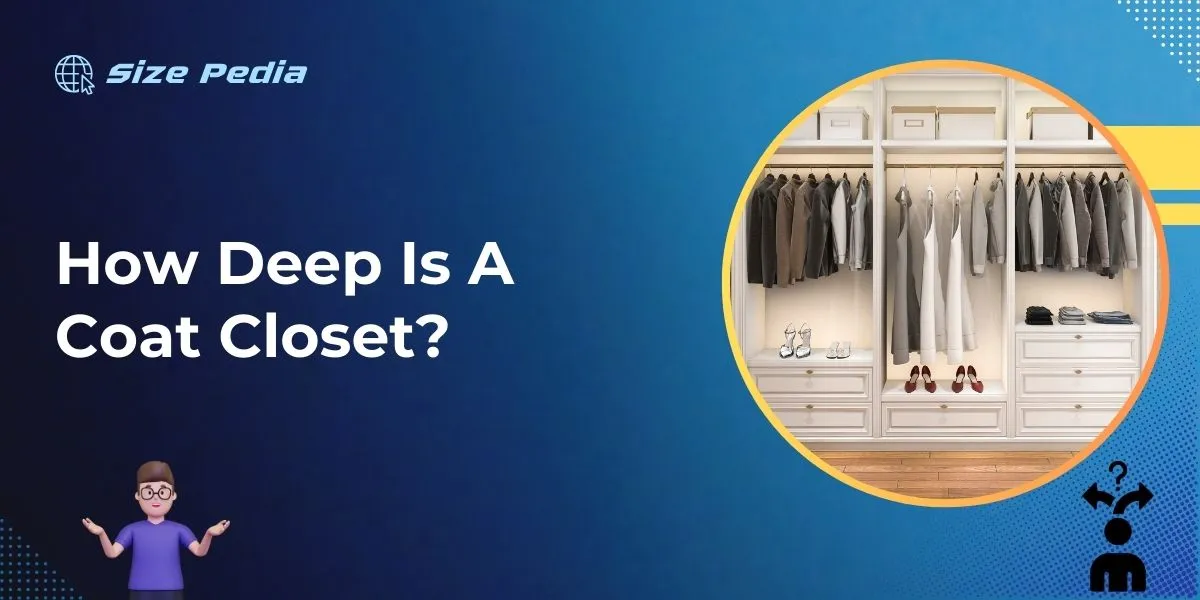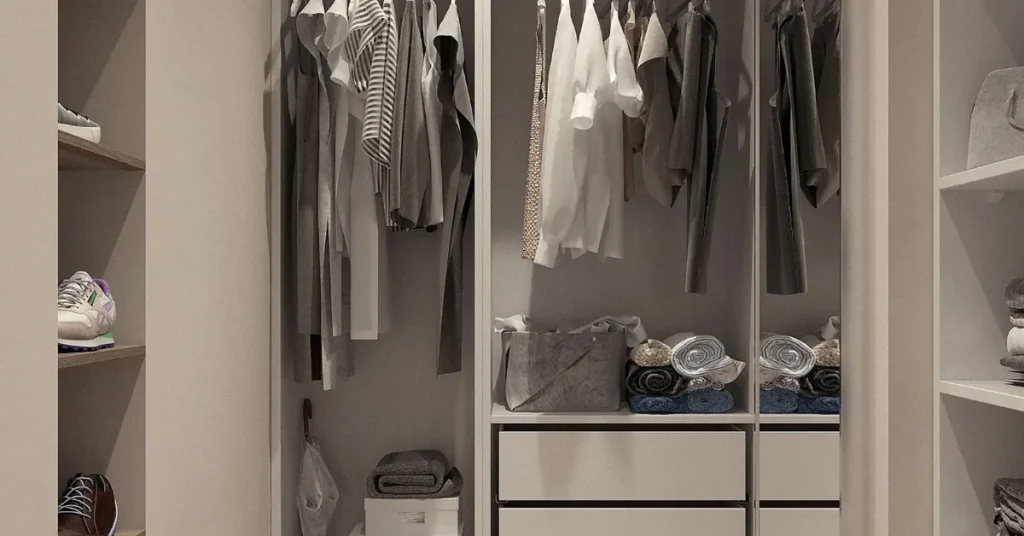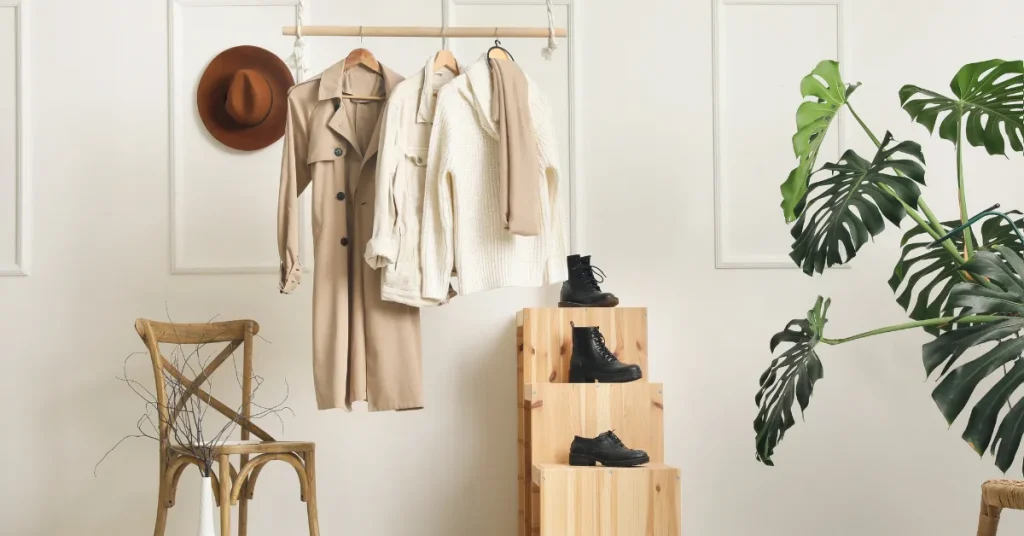A standard coat closet is typically 24 inches deep. This depth accommodates most coats and hangers without the items protruding.
A coat closet serves as a functional and integral part of a home’s storage solutions, tucking away jackets, scarves, and outdoor accessories neatly within its confines.
Its typical 24-inch depth is thoughtfully designed to ensure that bulky items can be stored without obstruction to the closet door or adjacent walking areas.
Ensuring your entryway remains uncluttered, a well-proportioned coat closet provides quick access to outerwear while maintaining an organized appearance.
Selecting the right dimensions for a coat closet is crucial in both maximizing space efficiency and keeping your garments in pristine condition. Remember, the goal is to create a storage area that is both practical for daily use and seamless in design.

Ideal Dimensions For Coat Closets
Organizing your home starts with the right dimensions for each space. A coat closet is no exception. The size of your coat closet affects how it holds your outerwear and more. We will dive into the ideal dimensions that blend functionality and design.
Typical Depth Measurements
Depth is key for coat closets. A shallow closet might squash your coats. A too-deep closet could waste space. Here are common sizes:
- Minimum depth: 24 inches (sufficient for hanging coats)
- Average depth: 28 to 30 inches (allows more breathing room)
- Generous depth: 36 inches or more (for bulkier coats and storage)
Factors Affecting Size
Several factors shape your ideal coat closet size. They ensure your closet meets your needs. Consider these:
| Factor | Description |
| Entryway Space | More area can mean a larger closet. |
| Coat Bulkiness | Thicker coats need deeper closets. |
| Storage Needs | Extra items may require extra space. |
| Home Style | Match the closet size with your home’s design. |
Maximizing Coat Closet Use

Are you ready to turn your coat closet from cluttered to curated? Maximizing the use of your coat closet can bring harmony to your entryway. With smart planning, a cozy closet can hold much more than coats.
Shelving And Organization Options
To make the most of your coat closet, think vertical storage. Shelves above the hanging rod are perfect for lesser-used items like seasonal hats or photo albums. Here are prime shelving and organizing tricks:
- Add adjustable shelves for flexibility with items of different sizes.
- Use stackable bins to separate scarves, gloves, and other accessories.
- Door racks can hold shoes or provide extra space for bags.
Hanging Space Necessities
Adequate hanging space is key in a coat closet. To ensure your coats stay wrinkle-free and accessible, consider the following:
| Item | Space Required |
| Thick Winter Coats | 2-3 inches each |
| Light Jackets | 1-2 inches each |
| Dresses or Suits | 2-3 inches each |
- Install double hanging rods for maximizing space.
- Leave room for long-hanging items on one end.
- Hooks work well for quick-grab items like dog leashes or umbrellas.
Customizing Your Coat Closet
Customizing Your Coat Closet, is not just about depth and storage. It’s about making the most of the space. A coat closet can be more than a home for coats. It becomes a functional, neatly organized nook with the right design.
From small apartments to large homes, a custom coat closet offers storage solutions — no matter the size!
Designs For Different Spaces
Coat closets don’t come in one-size-fits-all. Here are ways to tailor them to your space:
- For small homes: Slim, vertical designs save floor space.
- Spacious residences: Built-in benches and shelving utilize the generous area.
- Unusual layouts: Custom racks and hooks fit in quirky spaces.
| Space | Design Tip |
| Narrow | Opt for a shallow closet depth with multiple levels. |
| Wide | Include horizontal shelves for varied storage. |
Innovative Storage Solutions
Maximizing coat closet functionality sets your space free. Consider these ideas:
- Adjustable shelving caters to different item heights.
- Pull-out baskets sort accessories and contain clutter.
- Over-the-door organizers hold smaller items, freeing shelf space.
Remember, clever use of space makes for easy access and organization. Every inch counts!
The Importance Of Depth
The Importance of Depth in a coat closet cannot be overstated. Depth is a key factor that determines how well a closet serves its purpose.
Not only does it affect how many items you can store, but it also influences easy access and the longevity of your outerwear. Understanding the optimal depth for your coat closet ensures you get the most out of this vital storage space.
Accommodating Various Coat Types
Coat closets must cater to a wide range of outerwear, from light windbreakers to heavy winter coats. A standard coat closet is around 24 inches deep, a size that can comfortably accommodate most coats without them being cramped or getting crushed. Consider the following points:
- Bulkier coats need more space to maintain their shape.
- Padded hangers can help preserve the form of delicate items.
- Extra space allows airing out damp garments after outdoor wear.
Impact On Closet Functionality
A well-designed closet depth plays a pivotal role in functionality. With adequate space, your closet can:
- Prevent clutter, making it easier to find what you need.
- Maximize storage, by fitting more items efficiently.
- Maintain order, even when adding new coats or removing others.
A deeper closet allows for additional storage solutions like shelves or bins for accessories such as hats, scarves, and gloves. This adds to the overall utility of your closet.
| Coat Type | Recommended Depth |
| Light Jackets | 18-20 inches |
| Heavy Coats | 24-28 inches |
Common Mistakes In Closet Design

Designing a coat closet might seem straightforward, but common mistakes can lead to frustration. Dimensions matter.
Too often, closets fail to meet storage needs. Whether it’s a new build or a remodel, getting the size right is crucial for a functional closet. Let’s dive into some frequent missteps and how to sidestep them.
Overlooking Depth Requirements
The depth of a coat closet is vital for ample storage. Standard closets measure 24 inches deep, enough to hang coats without cramping. Misjudging this can lead to wrinkled attire and clutter. Here are some common depth-related errors:
- Ignoring bulky items: Not considering winter coats and outdoor gear.
- Forgetting the door swing: Failing to account for the space a door takes when open.
- Neglecting clearance: Overlooking the room needed for hangers and movement.
Practical Tips For Avoiding Errors
To ensure a functional coat closet, follow these tips:
- Measure outerwear: Assess the bulk of items for proper depth.
- Consider door options: Sliding or bi-fold doors save space.
- Plan for clearance: Leave at least 2 inches from the back wall.
Utilize shelving and hooks strategically to maximize space. Below is a table summarizing ideal closet dimensions.
| Item | Minimum Depth |
| Shirts/Blouses | 24 inches |
| Coats/Jackets | 28 inches |
| Shelving | 12 inches |
By paying attention to these aspects, you can create a closet that serves you well.
FAQs About How Deep Is A Coat Closet
What Is The Standard Depth For A Coat Closet?
The typical coat closet measures around 24 inches deep. This allows ample space for hangers and ensures that doors can close easily without brushing against the clothing.
Can Coat Closets Be Deeper Than Standard?
Yes, coat closets can be deeper than the standard 24 inches, especially if designed to store bulkier items. Depths of up to 28 inches are not uncommon for additional storage space.
How Can I Maximize My Coat Closet Depth?
To maximize a coat closet’s depth, use slimline hangers and add multiple levels of hanging rods. Clever use of hooks and shelves can also increase storage efficiency within the existing space.
Is Depth Important In Coat Closet Design?
Depth is crucial in coat closet design, as it influences both functionality and capacity. A well-proportioned closet accommodates various garment sizes and ensures ease of access and organization.
Conclusion
Understanding the typical depth of coat closets is crucial for home organization and design. Ideally, they range from 24 to 30 inches deep to accommodate various garment sizes.
Remember, customizing to fit your space and needs can make all the difference. Tailor your closet, maintain functionality, and enjoy a clutter-free entryway.
Resources:
1. https://www.fairfaxcounty.gov/news/holiday-giving-2021
